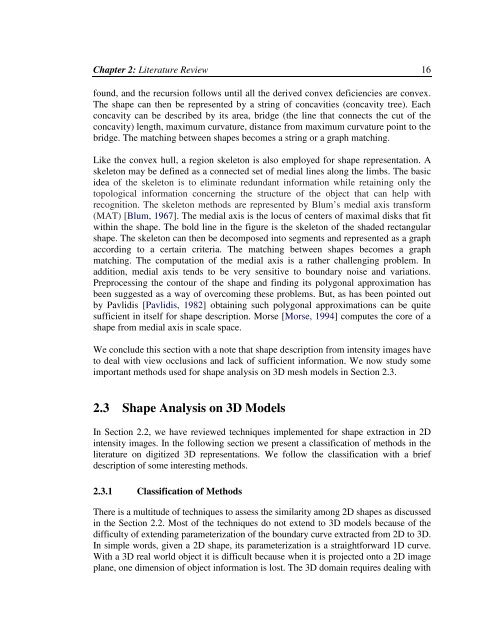Chapter 2: Literature Review 15feature vector. The binary H<strong>am</strong>ming distance is used to measure <strong>the</strong> similaritybetween two shapes. <strong>To</strong> account for <strong>the</strong> invariance to Euclidean transformations <strong>the</strong>shape needs to be normalized. Chakrabarti et al. [Chakrabarti et al., 2000] improve <strong>the</strong>grid descriptor <strong>by</strong> using an adaptive resolution (AR) representation acquired <strong>by</strong>applying quad-tree decomposition on <strong>the</strong> bitmap representation of <strong>the</strong> shape.Typically, shape methods use rectangular-grid s<strong>am</strong>pling to acquire shape information.The shape representation so derived is usually not translation, rotation and scalinginvariant. Extra normalization is <strong>the</strong>refore required. Goshtas<strong>by</strong> [Goshtas<strong>by</strong>, 1985]proposes <strong>the</strong> use of a shape matrix which is derived from a circular raster s<strong>am</strong>plingtechnique. The idea is similar to normal raster s<strong>am</strong>pling. However, ra<strong>the</strong>r than overlay<strong>the</strong> normal square grid on a shape image, a polar raster of concentric circles and radiallines is overlaid in <strong>the</strong> center of <strong>the</strong> mass. The binary value of <strong>the</strong> shape is s<strong>am</strong>pled at<strong>the</strong> intersections of <strong>the</strong> circles and radial lines. The shape matrix is formed such that<strong>the</strong> circles correspond to <strong>the</strong> matrix columns and <strong>the</strong> radial lines correspond to <strong>the</strong>matrix rows. Prior to <strong>the</strong> s<strong>am</strong>pling, <strong>the</strong> shape is scale normalized using <strong>the</strong> maximumradius of <strong>the</strong> shape. The resultant matrix representation is invariant to translation,rotation, and scaling. Since <strong>the</strong> s<strong>am</strong>pling density is not constant with <strong>the</strong> polars<strong>am</strong>pling raster, Taza et al. represent shape using a weighed shape matrix, which givesmore weight to peripheral s<strong>am</strong>ples in [Taza et al., 1989]. However, since a shapematrix is a sparse s<strong>am</strong>pling of shape, it is easily affected <strong>by</strong> noise. Besides, shapematching using a shape matrix is expensive. Parui et al. propose a shape descriptionbased on <strong>the</strong> relative areas of <strong>the</strong> shape contained in concentric rings located in <strong>the</strong>shape center of <strong>the</strong> mass in [Parui et al., 1986].Structural methods for region-based shape description usually involve <strong>the</strong> convexhulls and medial axis described in [Davies,1997], [Blum,1967] and [Morse,1994]. Aregion R is convex if and only if for any two points x 1 ; x 2 R, <strong>the</strong> whole linesegment x 1 x 2 is inside <strong>the</strong> region. The convex hull of a region is <strong>the</strong> smallest convexregion H which satisfies <strong>the</strong> condition R H. The difference H − R is called <strong>the</strong>convex deficiency D of <strong>the</strong> region R. The extraction of <strong>the</strong> convex hull can beachieved ei<strong>the</strong>r using <strong>the</strong> boundary-tracing method from [Sonka et al., 1993] or <strong>by</strong>using morphological methods from [Gonzalez and Woods, 1992]. Since shapeboundaries tend to be irregular because of digitization noise and variations insegmentation result in a convex deficiency that has small, meaningless componentsscattered throughout <strong>the</strong> boundary. Common practice is to first smooth a boundaryprior to partitioning. The polygon approximation is particularly attractive because itcan reduce <strong>the</strong> computation time taken for extracting <strong>the</strong> convex hull from O (n 2 ) to O(n) (n being <strong>the</strong> number of points in <strong>the</strong> shape). The extraction of convex hull can be asingle process which finds significant convex deficiencies along <strong>the</strong> boundary. Afuller representation of <strong>the</strong> shape is obtained <strong>by</strong> a recursive process which results in aconcavity tree. Here <strong>the</strong> convex hull of an object is first obtained with its convexdeficiencies, <strong>the</strong>n <strong>the</strong> convex hulls and deficiencies of <strong>the</strong> convex deficiencies are
Chapter 2: Literature Review 16found, and <strong>the</strong> recursion follows until all <strong>the</strong> derived convex deficiencies are convex.The shape can <strong>the</strong>n be represented <strong>by</strong> a string of concavities (concavity tree). Eachconcavity can be described <strong>by</strong> its area, bridge (<strong>the</strong> line that connects <strong>the</strong> cut of <strong>the</strong>concavity) length, maximum curvature, distance from maximum curvature point to <strong>the</strong>bridge. The matching between shapes becomes a string or a graph matching.Like <strong>the</strong> convex hull, a region skeleton is also employed for shape representation. Askeleton may be defined as a connected set of medial lines along <strong>the</strong> limbs. The basicidea of <strong>the</strong> skeleton is to eliminate redundant information while retaining only <strong>the</strong>topological information concerning <strong>the</strong> structure of <strong>the</strong> object that can help withrecognition. The skeleton methods are represented <strong>by</strong> Blum’s medial axis transform(MAT) [Blum, 1967]. The medial axis is <strong>the</strong> locus of centers of maximal disks that fitwithin <strong>the</strong> shape. The bold line in <strong>the</strong> figure is <strong>the</strong> skeleton of <strong>the</strong> shaded rectangularshape. The skeleton can <strong>the</strong>n be decomposed into segments and represented as a graphaccording to a certain criteria. The matching between shapes becomes a graphmatching. The computation of <strong>the</strong> medial axis is a ra<strong>the</strong>r challenging problem. Inaddition, medial axis tends to be very sensitive to boundary noise and variations.Preprocessing <strong>the</strong> contour of <strong>the</strong> shape and finding its polygonal approximation hasbeen suggested as a way of overcoming <strong>the</strong>se problems. But, as has been pointed out<strong>by</strong> Pavlidis [Pavlidis, 1982] obtaining such polygonal approximations can be quitesufficient in itself for shape description. Morse [Morse, 1994] computes <strong>the</strong> core of ashape from medial axis in scale space.We conclude this section with a note that shape description from intensity images haveto deal with view occlusions and lack of sufficient information. We now study someimportant methods used for shape analysis on 3D mesh models in Section 2.3.2.3 Shape Analysis on 3D ModelsIn Section 2.2, we have reviewed techniques implemented for shape extraction in 2Dintensity images. In <strong>the</strong> following section we present a classification of methods in <strong>the</strong>literature on digitized 3D representations. We follow <strong>the</strong> classification with a briefdescription of some interesting methods.2.3.1 Classification of MethodsThere is a multitude of techniques to assess <strong>the</strong> similarity <strong>am</strong>ong 2D shapes as discussedin <strong>the</strong> Section 2.2. Most of <strong>the</strong> techniques do not extend to 3D models because of <strong>the</strong>difficulty of extending par<strong>am</strong>eterization of <strong>the</strong> boundary curve extracted from 2D to 3D.In simple words, given a 2D shape, its par<strong>am</strong>eterization is a straightforward 1D curve.With a 3D real world object it is difficult because when it is projected onto a 2D imageplane, one dimension of object information is lost. The 3D domain requires dealing with
















